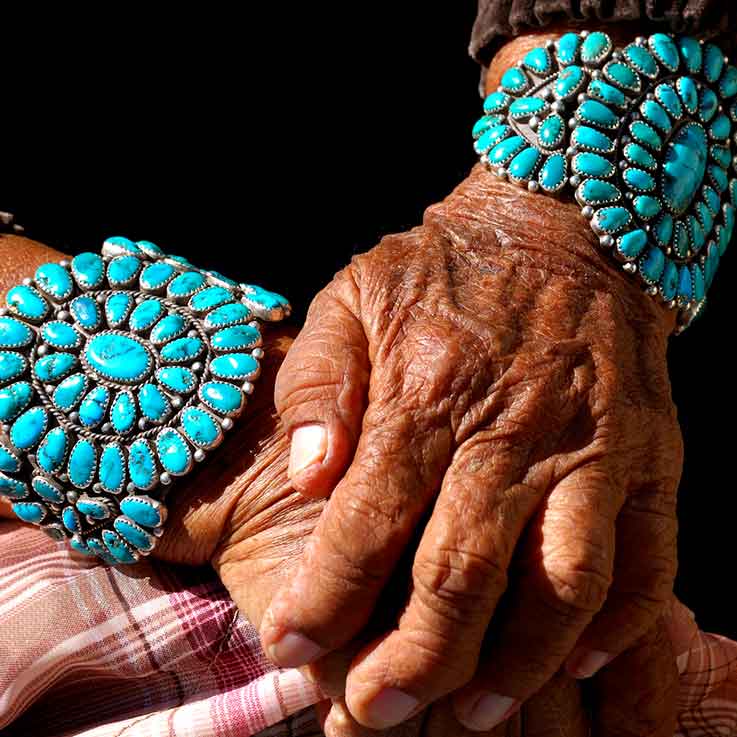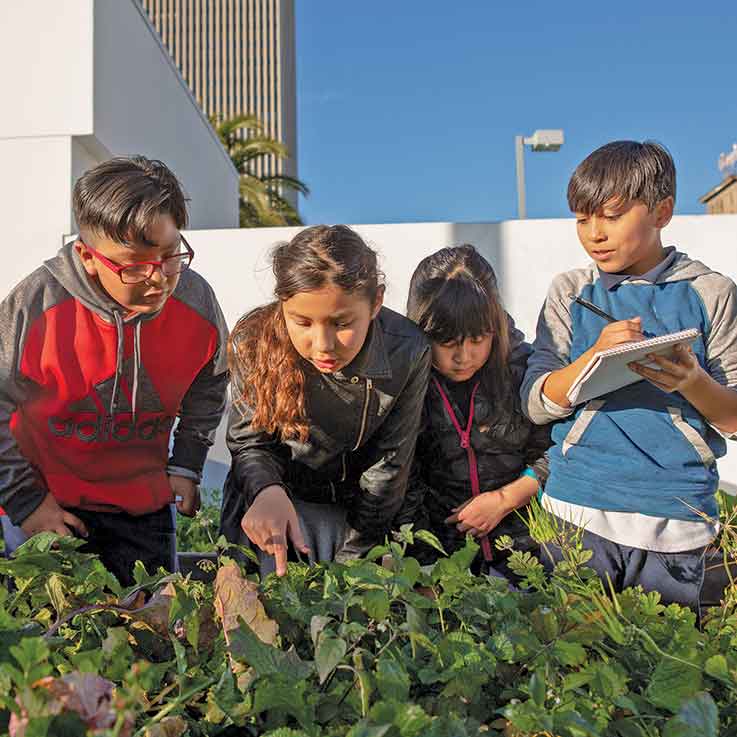
Indigenous Feminism Is Our Culture
Indigenous Feminism Is Our Culture
A call to bring back matriarchy in Indigenous communities to rebuild and decolonize the foundation of Native community life.
ByJihan Gearon Feb. 11, 2021
(Photo by iStock/Jerry Sodorff)
The words “Indigenous feminism” can be triggering in Indigenous communities. I’ve read op-eds in the Navajo Times saying “feminism is against our culture,” and when I do workshops on the topic, audiences are often defensive and push back on the phrase. I get it. I cringed the first several times I heard the phrase when I imagined strong Diné matriarchs like Juanita or my own grandmother transforming into powerless, basic “Karens,” like “before and after” photos at Carlisle Indian School.
We tend to associate it with mainstream feminism, an out-of-touch white worldview that devalues reproductive work—“women’s work”—and reinforces white supremacy and capitalism. But those of us Indigenous women who are privileged to be raised by our grandmothers and matriarchs know that the creation and caretaking of home is of the utmost sacred importance. And how could we be a part of a movement that does not value or even understand this?
Decolonization and Radical Indigenous FuturesThis series, presented in partnership between NDN Collective and SSIR, will explore the many ways Indigenous people are working to successfully solve issues that benefit their communities and, ultimately, all of us.FOLLOW THIS SERIES
Indigenous feminism can change our world, if given the chance. The particular words aren’t the important thing, and if others would rather call themselves “matriarch” or “matriarch-in-training,” or a word in their Indigenous language that means more to them, I say go for it. My goal is not to debate words or force everyone to use the same ones, but to insist that Indigenous feminism, like all solutions to problems in Indian Country, is about decolonizing. It’s about recognizing, naming, and discarding the worldview forced, reinforced, and enforced by this colonial experiment called the United States of America, and picking up the teachings and practices of our ancestors.
Indigenous feminism, or whatever you want to call it, is a part of that, or it should be.
Beyond Words, Beyond Theory
Loosely defined, Indigenous feminism is an intersectional theory and practice of feminism that focuses on decolonization, Indigenous sovereignty, and human rights for Indigenous women and their families. In my experience, unfortunately, it’s mostly theoretical and relegated to opinion pieces and books by professors. But we should go beyond definitions and theorizing: there is feminist work happening in Indigenous communities that I’d consider part of a uniquely Indigenous feminism (even if it isn’t explicitly named that).
For example, in 2019 as executive director of the Black Mesa Water Coalition, I hosted the Indigenous Feminist Organizing School with the Grassroots Global Justice Alliance and Indigenous Environmental Network. Our goals were to build relationships and develop a shared understanding and analysis of patriarchy in Indigenous communities. The school brought together ~70 Indigenous people from across the Americas, representing 35 different tribes doing various types of work. Some participants, like those representing Planned Parenthood and Rez Condom Tour, do feminist work in Indigenous communities. Others, as with Coalition to Stop Violence Against Native Women, address issues unique to Indigenous women. Others, like Indigenous Pride L.A. and Grownup Navajo, aim to bring Indigenous perspectives into the mainstream. And the work of groups like Black Mesa Water Coalition and Indigenous Environmental Network was rooted in protecting Mother Earth. Participants included birth workers, business owners, students, educators, and clan mothers.
The IFOS was a microcosm of the work of Indigenous feminism, and we learned a lot from the experience. We realized that we are at a stage of recognizing and naming patriarchy in our communities, and that we are hungry to continue the conversations with each other and get to a place of collective action and power. We learned about aspects to this developing feminism that are uniquely Indigenous, key issues like the disproportionate sexual abuse of Indigenous women and missing and murdered Indigenous women epidemic, priorities like our responsibility to Mother Earth and our homelands, and key barriers like the reality of colonization and its ongoing attempts to assimilate and terminate us (or rather, assimilate us to terminate us). And since decolonization requires we not only seek rights but reclaim and uphold our traditional roles and responsibilities, our feminism is as diverse as the hundreds of tribes across Turtle Island, each at their own stage of post-colonial evolution and with their own beliefs and practices.
Building on Matriarchal Foundations
Most importantly, our feminism remembers and can call upon a history in which our matriarchal systems—something mainstream feminism hasn’t yet achieved—not only actually existed but were practiced as essential aspects of our cultures. In some cases, this was just a few generations ago. Our cultures have survived in large part due to the strength of Indigenous women, and it is women who continue to lead today, despite not receiving credit or support.
However, we need to face it: The respect we hold for our grandmothers and matriarchs, and their roles in our culture, are not reflected in mainstream society. They’re not even reflected in our own communities, where you see patriarchy in our mostly—if not completely—cis-gendered and male tribal councils and leadership. You see it when male egos appropriate and impair movements created by the hard work of women’s organizing, when four out of five Native women are victims of violence, and when that violence is extended to the people of our queer communities. You see it when women are expected to put themselves last, and shamed if they don’t. You see it when we allow the destruction of Mother Earth so that rich people can be richer. You see it when we put our current comfort ahead of future generations' survival.
Patriarchy gives men power and privilege at the expense of women and acts as the framework for the domination and oppression of gay, queer, and transgender people, as well as the stunted development of men. In Indigenous communities, it also erases and twists Indigenous teachings and worldviews on gender and sexuality, namely the diversity and power of these aspects and experiences. After all, Diné people traditionally have four genders based on the role a person plays in the larger community. The roles of naadheeh (feminine man) and dilbaa’ (masculine woman) have a unique ability and responsibility to act as translators between asdzáá (feminine woman) and hastiin (masculine male, and they have a unique ability to bring about balance between the masculine and feminine.
Patriarchy, Colonialism, and Capitalism
However, patriarchy isn’t just entwined with the systems of colonization, white supremacy, and capitalism. Colonization, white supremacy, and capitalism need patriarchy to work.
Women’s work is the original subsidy for capitalism. Reproductive labor is necessary for social reproduction [everything it takes for a labor force to replicate itself]: purchasing household goods, preparing and serving food, laundering and repairing clothing, maintaining furnishings and appliances, socializing children, providing care and emotional support for adults, and maintaining kin and community ties. It involves manual, mental, and emotional labor. As more and more people have come to realize during the COVID-19 pandemic, every human being needs this kind of essential work to live. Yet, reproductive work rarely even counts as work at all. Patriarchy teaches that it’s the “natural” role of women, and so, where it is paid at all, it is underpaid.
This kind of capitalism and patriarchy goes hand in hand with colonialism. In Dinétah—my homelands now reduced to the Navajo Nation—we still practiced our traditional customs while we resisted the Spanish and were warring with the US, including our traditional matriarchal society that gave matriarchs the final say over land and resources. But when the US government force-marched ~9,000 of us to the Bosque Redondo internment camp in New Mexico, where we remained from 1864 to 1868, a time known as Hweeldi or the Long Walk, women were subject to new atrocities, commonplace rape, and forced into prostitution to survive.
This was the beginning both of institutional sexual violence against our women and of a transformation of how women were viewed by our own people. Imagine witnessing this violence and not being able to do anything about it; imagine having to encourage it in order to get food and other necessities.
Today, when our women are assaulted, we often ignore it. We simply rely on a Navajo woman’s strength to get her through it.
The story continued when we signed our treaty in 1868 and returned home to a much smaller homeland. In signing the treaty, we also agreed to have our children educated in the US system. This meant sending them to boarding schools and forcing them to assimilate into western ways of thinking and operating. In addition to learning white supremacy, these schools taught our people the gender binary and the roles associated with it: that women are less than men, that queer people are unnatural, etc.
When oil was discovered on Navajo Nation, a Navajo Nation Business Council was established in 1922, to sign leases and meet the demands of the oil companies. The Secretary of the Interior at the time, a friend to the oil industry, knew he could not open the Navajo Nation to oil development if he approached a diverse and distributed clanship system. So he created a “business council” and selected three Navajo men to serve on it. These men were likely born during hweeldi, and the first to be assimilated in boarding school. Men who were no doubt taught and encouraged to act on the belief that they, simply because they are men, should be decision makers and that fossil fuel development is progress. The business council marked the beginning of the end of traditional decision-making via matriarchal society.
Women still had their livestock, of course, which allowed them economic autonomy and success: In the 1870s, we had 15,000 sheep; in the 1920s, we had 500,000; and by 1931, we had 2 million. But the colonizer doesn’t want us to be successful, so the federal government conjured up a policy called The Navajo Livestock Reduction, purchasing, removing, and slaughtering our livestock (and arresting those who opposed it). They also set up a grazing system, which ensured we would not be able to grow our herds again and that system is still used today. While this killed the economic autonomy of the Navajo people, it particularly impacted the women because they owned those herds. Men were away working as laborers, while women and their families still relied heavily on the sheep economy to survive. Killing these herds ensured that Navajo women too would have to depend on the wage labor, decisions, and direction of Navajo men.
If capitalism is the system and colonization is the practice, patriarchy is the foundation of both. In the span of 70 years, the colonizers stole our land and resources and twisted cultural understanding of gender roles and responsibilities. Federal reorganization and assimilation policies continued into the 1960s. My own mother was part of the relocation policies that moved Indigenous people from their homelands to the cities in order to speed up assimilation. So it’s no wonder that the fossil fuel economy took over our homelands starting in the early 1970s. It’s no wonder that while the cis-male run tribal government signed these deals with Peabody Coal Company, it was the matriarchs of Big Mountain and Black Mesa who fought against it and continue to do so.
Matriarchy Today
Where our culture has remained strong, it’s because of Navajo women. And our matriarchs still exist today. Indigenous women are strong leaders, today. People like Enei Begaye-Peter of Native Movement, Wahleah Johns of Native Renewables, and Eriel Deranger of Indigenous Climate Action who have not only dedicated their lives to protecting our homelands but are also advancing real world examples of a just transition away from extractive economies. It’s women like Lillian Hill of Hopi Tutskwa Permaculture Project, Linda Black Elk at United Tribes Technical College, and Nicole Gonzales of Changing Woman Initiative who are learning and sharing our traditional knowledge for the health of our people. It’s women like Ethel Branch and Janene Yazzie of Navajo & Hopi Families COVID-19 Relief who are supporting and keeping our people safe during the COVID-19 epidemic. And there are many others. Because that is our way. It is our job to take care of our home and homelands. And we continue to do that despite patriarchy’s goal to appropriate our autonomy, agency, and power as Indigenous women.
Imagine how much better this work will be when Indigenous matriarchs have autonomy, agency, and power once again. Not power over men or others, but transformative power, which grows from respect for self and equality with others, in all their diversity of identity, experience, and ability. This is the crux of Indigenous feminism.
Indigenous feminism has a lot of growing up to do, especially here the United States, but we are not alone. Sector de Mujeres in Guatemala have already created many political education tools to advance Indigenous feminism in Mayan communities and are willing to work with and support us. Grassroots Global Justice Alliance is hosting Feminist Organizing Schools across the US, advancing grassroots feminism, and developing opportunities for Indigenous, Black, and other women and queer people of color to collaborate and advance together. The World March of Women mobilizes millions of women across the world in collective action and offers decades of knowledge and experience.
Indigenous feminism requires us to not only fulfill our cultural roles but also to correct how those roles have been twisted by colonization and patriarchy. It demands that we ask difficult questions and have difficult discussions. We must question and challenge even what’s been taught to us as “traditional.”
There is a Navajo prophecy that says that when women are in leadership, many bad things will happen to our people and in the world, that we’ll lose our language and culture and children. In practice, I’ve seen this prophecy used as an argument against electing a woman as Navajo Nation President, and many Navajo people still refuse to do so. But I think patriarchy has layered itself over this prophecy by invoking fear of our future, women leadership, and change. It keeps us right where we are, which is a place of bad things happening to our people and the world, of us losing our language and culture. That time is already here, but I do not choose fear. I look to the matriarchs in my life, to their work defending our homelands, speaking on behalf of the earth, water, animals, and future generations, and realize I believe in the prophecy too. I believe the prophecy means the leadership of women is most needed now.










